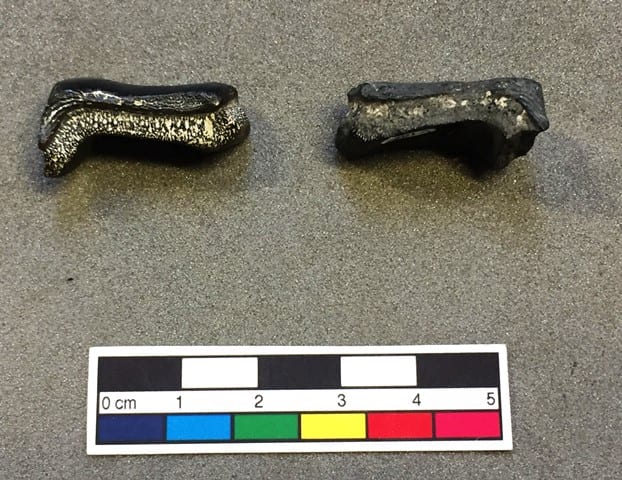Underwhelming Fossil Fish of the Month December 2017
By Mark Carnall, on 31 December 2017
2017 is nearly done but there’s just enough time to make it just that little bit more underwhelming than it already was otherwise. If you’ve arrived here by some strange quirk or questionable Googling and missed the previous 59 underwhelming fossil fishes, then there’s still time for you to back out. There’s no shame in it. You can still keep a clean sheet, boredom-wise. If you insist on carrying on then let me tell you what’s in store. Each month we take a look at one of the incredibly uninspiring fish fossils from the Grant Museum of Zoology collection. The goal of this apparently fruitless task is to increase the global fossil fishteracy one fossil fish at a time. It’s a Sisyphean task because, gosh darnit, these fossil fish are hard to care about.
Before we get down to business, however, being a December post, it’s time for END OF YEAR ROUND-UP FILLER CONTENT! We had twelve months this year and almost as many underwhelming fossil fish. There was no underwhelming fossil fish in January instead there was this ridiculous pomp and bluster. February was a petrified pastie. Adhesive and European idioms couldn’t save us from March. April’s child is fair of face. May was miserable. June was very shiny. Very shiny. July’s was as fresh as a decomposing whale. August’s fossil was kept back for health and safety reasons. September was one to remember.. NOT. October’s fossil fish was tongue firmly out of cheek. The less said about November, the better all round really. That brings us to December which is now, which is here!

LDUCZ-V107 Two slugs on sun loungers or Lagarodus specularis? This week we’ve got a jauntily angled scale bar for some end of the year silliness for you. It’s not all dry interpretation here at UFFotM.
What we have here is, purportedly, two teeth of Lagarodus specularis, which characteristically resemble tabs of chewing gum with a fold in them. According to the database information these specimens were collected from Myachkovo quarry in Moscow Province and were acquired by the Museum in 1900/1901.
Lagarodus is a genus of cartilaginous fish from the Upper Carboniferous, around 300 million years old, and is well known from Russian deposits. Lagarodus has speculatively been identified as a chimaera, the group of fish whose modern relatives include rabbit fish, spookfish and rat fish, however, more recent work is more cautious about exactly how these fishes fit in taxonomically (Lebedev 2008).
Preservation These two ‘teeth’ fossils are not teeth like ours but it is thought that they would tessellate with other flat teeth to have formed a flat ‘pavement-like’ battery on the lower and upper jaws. These flat, hard teeth arranged in batteries would have likely been used to crush shelled prey, like molluscs and crustaceans. This kind of predation is called durophagy and we see analagous, or parallel, adaptations in modern species of skates and rays as well as in the fossil record. Like other cartilaginous fish (sharks, skates, rays etc.) it is thought that Lagarodus would have replaced teeth through life, perhaps explaining why isolated teeth like this are quite common in the fossil record. So far articulated batteries are not known from the fossil record. The black slug-like part of these fossils would have been the hard crushing surface and the sun lounger part underneath, the root of the tooth plate. These slightly bent teeth would have probably been from near the middle of the tooth battery on the lower jaw.
Scientific Research For a long time it was thought that these teeth belonged to the same group as Psammodus, a fossil fish we’ve covered here before, however, the presence of enamaloid (hard-enamel-like material) has warranted the creation of its own group (Lebedev 2008). Previously, similarly formed but slightly differently shaped teeth were thought to represent species level variation in the genus Lagarodus and three species were named- angustus, cubicus and specularis. In the most recent review (and pretty much the only recent research on these fossils) puts all Lagarodus species into one, Lagarodus specularis, with the three former species names now being the morphotype (shape form) names for the differently shaped teeth (Lebedev 2008).
In Society It’s fair to say that Lagarodus has had a limited impact on wider society. Known from only isolated teeth, we don’t even know how these teeth really slotted together, what this fish would have looked like and how it fits in with with the wider cartilaginous fish group. What these fossils lack in scientific importance is matched only by their aesthetic appeal, that is to say, next to none.
Lagarodus specularis
Preservation 7
Research 3
In Society 0
Underwhelmingness 8.5
References
Lebedev, O. E. 2008. Systematics and dental system reconstruction of the durophagus chondrichthyan Lagarodus, Jaekal 1898. Acta Geologica Polonica. Vol 58, No 2, 199-204. Weblink here.
Mark Carnall is the Collections Manager (Life Collections) at the Oxford University Museum of Natural History and former Curator of the Grant Museum.
7 Responses to “Underwhelming Fossil Fish of the Month December 2017”
- 1
-
2
John Omega wrote on 6 January 2018:
That cartilaginous chimera sure had some crusty looking clam crushers!
-
3
mobile prices Bangladesh wrote on 8 August 2018:
i love fossil.sure had some crusty looking clam crushers!
- 4
- 5
- 6
- 7
 Close
Close


amazing collection..
thanks ucl.